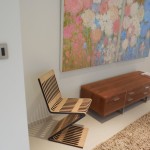The Zag Zig Chair might be the most uniquely shaped piece in the Möbel Link Line. This chair maintains an astounding level of comfort while making a striking statement. First made from solid elm wood by Gerrit Rietveld in 1934 and called the Zigzag chair. We have recreated and redesigned our own version of the chair which is constructed from 88 pieces of a sheet of precisely machined Baltic birch plywood, which are doweled, glued, and nailed together.
Due to the inherent springiness of the structure the chair bends to fit you as it contours to your body. This chair’s paradoxical structure will gently allow you to move while offering firm support while you sit in it. The natural reaction for people using this chair is to want to move around in it and that is why this chair’s is aptly nicknamed ADHD.











